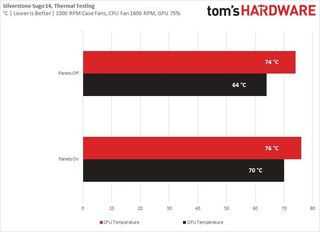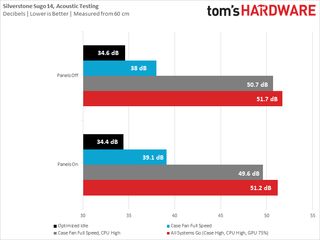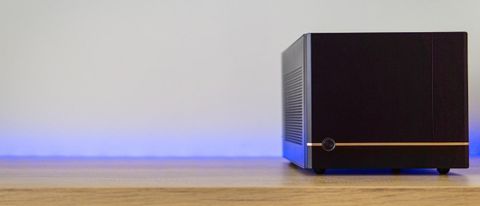Why you can trust Tom's Hardware
Testing
To test the Sugo 14, I subjected the system to Prime95 workload at smallest FFT’s on the CPU for maximum heat generation, and Furmark to get the GPU all nice and toasty. The following results are all at maximum fan speeds, except for the GPU, which ran at a maximum of 75% as it gets extremely loud otherwise, and Nvidia’s drivers never push the GPU above these levels anyway.

Thermally, the Sugo 14 actually jots down quite a good performance. With the panels on, the CPU ran at about 76 degrees Celcius, with the GPU at a slightly cooler 70 degrees C. These are respectable figures, and it’s clear that placing intake of each right next to a meshed side panel is helping. The temperatures drop somewhat when removing the panels, but the difference isn’t all that drastic, which is a good sign.

However, acoustically things get a little loud. Of course, this is an open-mesh case, and therefore we shouldn’t be all too surprised at louder acoustics. But in all honesty, I wouldn’t read into the above numbers all too much. As you can see, matters are perfectly reasonable with the optimized idle scenario (with the included fan running at about 500 RPM), and with the case fan spinning at full speed (1350 RPM) noise levels are good too.
The reason why the other two figures are high is because the Corsair H100i Elite Capellix cooler runs extremely loud with the fans spinning at a mighty 2250 RPM, and the RTX 2070 Super FE is also loud compared to aftermarket GPUs with bigger coolers.
This means that in practice, with some fan curve optimization, you should be able to get much better acoustics – because clearly the thermal headroom is there to run matters quietly.
Conclusion
When I started working on the Sugo 14, I wasn’t happy with it. It’s made from cheap painted steel with an even cheaper plastic front panel, and it looks like a household appliance more than it does a piece of art. Even after reviewing it, I genuinely find it an off-putting device.
This is a bit of a bummer when you consider that the Phanteks Evolv Shift 2 comes in at the exact same price of $110. That case has two massive tempered glass panels, and on the front and back two beautifully milled aluminum panels – it’s so pretty that I rebuilt my old PC from my student times into it, and put it on display in my living room. I can’t get away with that with the Sugo 14, as even my non-techy partner had an averse reaction to it walking into my office: “what is that?!”
In that sense, the aluminum-clad Sugo 15 with identical internals to the Sugo 14 might be more to our taste, but that chassis comes in at a hefty MSRP of $179.
Then again, ITX cases generally are overpriced compared to their ATX counterparts, because of low production volumes, and for some reason, the Evolv Shift 2 is priced much lower than the vast majority of other ITX cases out there, so maybe it’s not an entirely valid comparison.
However, when I started working with the Sugo 14, that’s when I started to understand its appeal. The internal layout offers an extremely convenient layout. The use of full-size ATX PSUs is something I can appreciate for practicality’s sake, and I like the modular approach to the side bracket that allows you to install either a watercooling radiator, two hard drives, an optical drive, or a mix of those by means of some sacrifices.
I laid the system out for the GPU to draw in from one side, the CPU’s AIO from the other side, and all to be exhausted out the back. This resulted in great thermals, which the Phanteks Evolv Shift 2 isn’t able to match even in its air variant because it only has room for up to a 120mm AIO.
If you value practicality and performance above all else, then the Sugo 14 might just be the ITX case for you. Want looks to go with it, and you could consider dropping more money on the Sugo 15 instead – though that chassis won’t have room for an optical drive.
Practically, the Sugo 14 offers everything you’d likely want from an ITX case with an excellent internal layout and superb thermals. It’s just not as pretty as I’d like for a system that would live full-time on my desk.
MORE: Best Cases
MORE: All Case Content
Niels Broekhuijsen is a Contributing Writer for Tom's Hardware US. He reviews cases, water cooling and pc builds.
-
zodiacfml Nice but pricey. I'd pay $40-50 but PC cases could be redundant and I will experiment an open air system soon.Reply -
g-unit1111 I'm seriously thinking of building a full ITX rig at some point and have been case shopping. I like Silverstone cases for this purpose and have used them in the past. This looks interesting for sure.Reply -
G Master Reply
Those are known as "dust magnets". You'll see.zodiacfml said:Nice but pricey. I'd pay $40-50 but PC cases could be redundant and I will experiment an open air system soon. -
Mr5oh "classic 5.25-inch optical drive – when’s the last time you saw that?"Reply
Silverstone understands what the case might actually be used for? I have three HTPCs, all in Silverstone cases all with optical drives. If you use a PC as a media machine you may actually want to play DVDs / BluRays in it. Just a thought. -
kyzarvs ReplyMr5oh said:"classic 5.25-inch optical drive – when’s the last time you saw that?"
Silverstone understands what the case might actually be used for? I have three HTPCs, all in Silverstone cases all with optical drives. If you use a PC as a media machine you may actually want to play DVDs / BluRays in it. Just a thought.
I use mine for the DVD copy of San Andreas so I still have the radio stations... Finished a playthrough over Christmas -
Glock24 "Against:Reply
Looks plain"
I'll count that as a pro, not everything needs RGB LEDs or flashy tribal decorations or funky colors. Plain is nice, plain is elegant. -
Giroro This seems like a good case that I would consider for a mini ITX build.Reply
But the "U3, U2" labeling on the front USB rubs me the wrong way a bit. That's not really normal, so it makes me wonder "what else isn't normal".
It's like buying Ikea furniture, where everything is almost right, but still just a little bit off". For example the 'PC gaming' desk I bought at Ikea with a computer shelf that is about half an inch too short to fit 90% of the popular mid-tower cases on the market, even though they had room to easily make the shelf 2 inches taller and fit almost everything.
A mini itx case would fit the desk, though. -
MrAOK 14" deep is way too deep for an ITX build. It defeats the purpose of having an ITX buildReply


